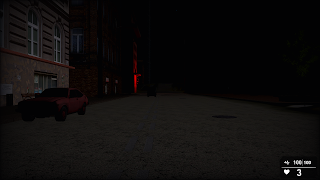 |
| Picture courtesy of Lee Bamber's now extinct dev log. |
 |
| Literally the same system in practice. |
That said, at some point, Lee realized this was a titanic error and fixed it to provide a significantly better fog system. We ended up with something vastly better:
 |
| This is an old picture, but shows the lower limits of what's possible. |
Realistic nighttime!
So with that we approach our first technique; realistic nighttime. In game-guru, nighttime effects are actually quite difficult to achieve. This is primarily because the sky system has a constantly active light which will frequently circumvent your efforts. This light is fixed in space and you can turn down ambient/shadow values to zero but your game will still fall short of achieving that desired 'nighttime' look.The trick, the real trick, is to use fog. If you set all the values to 1 for RGB, set the range start up close and the far distance close, then modify the intensity as desired it will create a black fog which accurately mimics the feel of night and it's creeping darkness.
As you can see from this picture: it looks silly with a daytime sky.
But if you add a nighttime sky, it all falls together. The best part is it accurately sets up flash-light fall-off.
As you can see, it looks far more like night.
Distance simulation with Fog
One common mistake I see in Game-Guru games is that they very frequently don't factor in standard atmospheric effects. This in turn, makes their own job HARDER. | |||
| Not a bad city depiction, texture misalignment aside. |
Compare this against GTA IV:
 |
| Can you guess the difference? |
Haze is defined as: "Traditionally an atmospheric phenomenon where dust, smoke and other dry particles obscure the clarity of the sky."
What you'll find is in almost every scene, from top to bottom at least a slight tinge of fog on the outlying distance (use your total visible range in an average scene, add fog to the last 15-20%) will have atmospheric haze.
 |
| Don't overdo it, or you'll look like silent hill. |
When implementing your haze, you want to keep in mind that time of day matters; remember haze is effectively a reflection or light being blocked. As the time of day changes, so too does the haze.
 |
| Not a game-guru picture. Just some random image from google. |
This is more what you're striving for:
 |
| From Twin Worlds - Note the orange haze, matching the sky perfectly. |
Further examples(settings included):
My city test - day, with Atmospheric (normal) coloring:
 |
| If you further modify your depth of field settings you can achieve a more pleasing result, but this fairly decent for a quick example. |
 |
| This is a longer range darkness, but still dark. I left the cloudy sky in for contrast. |
Now is a really dark version - high intensity. Distance remains the same.
 | ||||
| Notice how the red light is no longer visible. |
 |
| I had to move close just so you could see anything!! |
 |
| My favorite, personally speaking. |
Silent hill, just because :P
 |
| Just add pyramid head. |
As always, feel free to comment. If this has been useful to me, please post a link to your results below!


1 comment:
Good stuff, great advice!
Post a Comment